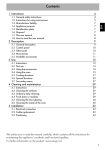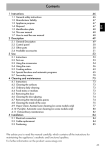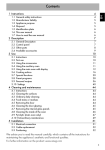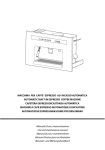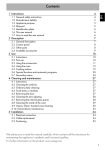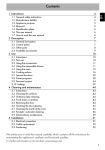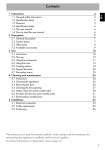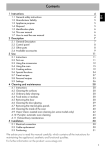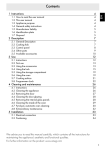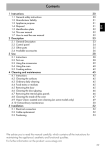Download User manual
Transcript
Contents 1.1 1.2 1.3 1.4 1.5 1.6 1.7 1.8 General safety instructions Instructions for using microwaves Manufacturer liability Appliance purpose Identification plate Disposal This user manual How to read the user manual 2 Description 2.1 2.2 2.3 2.4 2.5 General Description Control panel Other parts Microwaves Available accessories 3 Use 3.1 3.2 3.3 3.4 3.5 3.6 3.7 4 5 7 7 7 7 8 8 9 9 10 11 11 12 13 Instructions First use Using the accessories Using the oven Cooking functions Special functions and automatic programs Secondary menu 4 Cleaning and maintenance 4.1 4.2 4.3 4.4 4.5 4.6 4.7 4 EN 1 Instructions Instructions Cleaning the surfaces Ordinary daily cleaning Food stains or residues Cleaning the door glazing Cleaning the inside of the oven Vapour Clean: Assisted oven cleaning (on some models only) 5 Installation 5.1 Electrical connection 5.2 Cable replacement 5.3 Positioning 13 15 15 16 18 28 34 36 36 36 36 37 37 37 39 42 42 42 43 We advise you to read this manual carefully, which contains all the instructions for maintaining the appliance’s aesthetic and functional qualities. For further information on the product: www.smeg.com 3 Instructions 1 Instructions IMPORTANT SAFETY INSTRUCTIONS PLEASE READ CAREFULLY AND RETAIN FOR FUTURE USE. 1.1 General safety instructions Risk of personal injury • WARNING: If the door or the door seal is damaged, the oven must not be used until it has been repaired by a competent person. • WARNING: It is hazardous for anyone other than a competent person to carry out any service or repair operation which involves the removal of a cover which offers protection against exposure to microwave energy. • WARNING: Liquids and other foods must not be heated in sealed containers since they are liable to explode. • WARNING: During use the appliance and its accessible parts become very hot. • Never touch the heating elements during use. • Keep children under eight years of age at a safe distance if they are not constantly supervised. • This appliance may be used by children aged at least 8 and by people of reduced physical or mental capacity, or lacking in experience in the use of electrical 4 appliances, as long as they are supervised or instructed by adults who are responsible for their safety. • Children must never play with the appliance. • The appliance must never be cleaned by unsupervised children. • Switch off the appliance immediately after use. • If smoke is emitted, switch off or unplug the appliance and keep the door closed in order to stifle any flames. • Never attempt to extinguish a flame or fire with water. • Have qualified personnel carry out installation and assistance interventions according to the standards in force. • Do not modify this appliance. • Do not insert pointed metal objects (cutlery or utensils) into the slots in the appliance. • Do not try to repair the appliance yourself or without the intervention of a qualified technician. • If the power supply cable is damaged, contact technical support immediately and they will replace it. Instructions 1.2 Instructions for using microwaves • Check the appliance visually during the cooking of foods in plastic or paper containers. EN Risk of damaging the appliance • Do not use abrasive or corrosive detergents on glass parts (e.g. powder products, stain removers and metallic sponges). • Use wooden or plastic utensils. • Do not use steam jets to clean the appliance. • Do not obstruct ventilation openings and heat dispersal slots. • Never leave the appliance unattended during cooking operations where fats or oils could be released. • Do not use the appliance to heat rooms for any reason. • Do not rest any weight or sit on the open door of the appliance. • Take care that no objects are stuck in the doors. Improper use Danger of explosion • When using the microwave to heat or reheat liquids, the boiling process may be delayed – boiling temperature can be reached without the formation of the usual "rolling boil". This delayed boiling and consequent superheating of the liquid can generate an explosion inside the appliance, or sudden boiling over of the superheated liquid can occur when removing the container from the appliance. To avoid these dangers, it is necessary to insert the supplied boiling rod (or a heat-resistant plastic spoon) in the container while heating. • Use the microwave only for the preparation of food for consumption. Other types of applications are strictly forbidden (e.g. drying clothes, warming slippers, sponges, wet cloths or the like, dehydrating foods) because they can lead to the risk of injury or fire. 5 Instructions • Clean the appliance constantly and remove any food residue. • Do not use the microwave to dry food. • Do not use the microwave to heat oils or fry. • Do not use the appliance to heat foods or beverages containing alcohol. • Baby food should not be heated in sealed containers. Remove the cover or the teat (in the case of baby bottles). Always check the preparation's temperature once heating has completed, it should not be too high. For an even temperature and to avoid scalding stir or shake the contents. • Do not heat eggs in their shells or whole hard boiled eggs; they may explode even after the heating process has completed. • Before cooking food with a hard skin or peel (e.g. potatoes, apples, etc.) it is necessary to puncture the skin. • Do not heat food contained within food packages. • Do not use the microwave functions when the oven is empty. • Use cookware and utensils that are suitable for use in a microwave oven. • Do not use aluminium containers 6 to cook food. • Do not use dishes with metallic decorations (gold-plated or silver). • The appliance operates in the 2.4GHz ISM band. • In compliance with the provisions relating to electromagnetic compatibility the appliance belongs to group 2 and class B (EN 55011). • This appliance complies with the standards and directives currently in force concerning safety and electromagnetic compatibility. It is however recommended for pacemaker wearers to maintain a minimum distance of 20-30cm between the microwave when it is operating and the pacemaker. Consult the pacemaker manufacturer for more information. 1.3 Manufacturer liability The manufacturer declines all liability for damage to persons or property caused by: • Use of the appliance other than the one envisaged; • Non-observance of the user manual provisions; • Tampering with any part of the appliance; • Use of non-original spare parts. 1.4 Appliance purpose • This appliance is intended for cooking food in the home environment. Every other use is considered inappropriate. Instructions 1.5 Identification plate The identification plate bears the technical data, serial number and brand name of the appliance. Do not remove the identification plate for any reason. equivalent product, on a one for one basis. Our appliances are packed in nonpolluting and recyclable materials. • Deliver the packing materials to the appropriate recycling centre. EN Moreover, it cannot be used: • in employee kitchens, shops, offices and other working environments. • in farms/agritourism establishments. • by guests in hotels, motels and residential environments. • in bed and breakfast establishments. • The appliance is not designed to operate with external timers or with remote-control systems. Plastic packaging Danger of suffocation • Do not leave the packaging or any part of it unattended. • Do not let children play with the packaging plastic bags. 1.6 Disposal This appliance must be disposed of separately from other waste (Directives 2002/95/EC, 2002/ 96/EC, 2003/108/EC). The appliance does not contain substances in quantities sufficient to be considered hazardous to health and the environment, in accordance with current European directives. Power voltage Danger of electrocution • Disconnect the main power supply. • Disconnect the power cable from the electrical system. To dispose of the appliance: • Cut the power supply cable and remove it along with the plug (if present). • Deliver the appliance to the appropriate recycling centre for electrical and electronic equipment waste, or return it to the retailer when purchasing an 7 Instructions 1.7 This user manual 1.8 How to read the user manual This user manual is an integral part of the appliance and must therefore be kept in its entirety and within the user’s reach for the whole working life of the appliance. • Read this user manual carefully before using the appliance. This user manual uses the following reading conventions: Instructions General information on this user manual, on safety and final disposal. Description Description of the appliance and its accessories. Use Information on the use of the appliance and its accessories, cooking advice. Cleaning and maintenance Information for proper cleaning and maintenance of the appliance. Installation Information for the qualified technician: Installation, operation and inspection. Safety instructions Information Advice 1. Sequence of instructions for use. • Standalone instruction. 8 Description EN 1.9 Description 1.10 General Description 1 Control panel 2 LH Light bulb 3 RH Light bulb (on some models only) 4 Seal 5 Door 6 Oven fan 7 Rack/tray support frames Frame shelf 9 Description 1.11 Control panel Temperature knob (1) Function knob (3) This knob is used to select: • Microwave power level • Cooking temperature • Function's duration • Programmed cooking procedures • Current time • Switching on or off of the appliance internal lamp. This knob can be used to: • Turn the appliance on and off • Select a function • Temporarily start or stop a function. Display (2) Displays the current time, the selected cooking function, power and temperature and any time set. 10 1.12 Other parts 1.13 Microwaves Shelves The appliance is equipped with a microwave generator called a magnetron. The microwaves generated are evenly emitted into the oven compartment in order to reach the food and heat it. Heating takes place through the process of friction between the molecules contained in the food (mainly water molecules), with the consequent generation of heat. The heat generated directly inside the food leads to defrosting, re-heating or cooking in a shorter length of time compared to traditional cooking. The use of suitable containers for microwave cooking allows the microwaves to reach the food in a uniform manner (see Materials suitable for microwaves). The appliance features shelves to position trays and racks at different heights. The insertion heights are indicated from the bottom upwards (see 1.10 General Description). Cooling fan The fan cools the oven and comes into operation during cooking. The fan causes a steady outflow of air from above the door which may continue for a brief period of time even after the appliance has been turned off. Interior lighting The oven light comes on when the door is opened or any function is selected. To save energy, the lamp will remain on for one minute at the beginning of each cooking cycle (this feature can be disabled through the secondary menu). Turn the temperature knob briefly to the right to activate or deactivate internal lighting. 11 EN Description Description 1.14 Available accessories Tray rack Some models are not provided with all accessories. Rack To be placed over the top of the oven tray; for cooking foods which may drip. Boiling rod Useful for supporting containers with food during cooking. Glass dish To be placed in containers when heating liquids, necessary to avoid delayed boiling with resulting superheating. The oven accessories intended to come into contact with food are made of materials that comply with the provisions of current legislation. Useful for any type of cooking and collecting fat from foods resting on the rack above. 12 Original supplied and optional accessories can be requested to Authorised Assistance Centres. Use only original accessories supplied by the manufacturer. Use 2.1 Instructions High temperature inside the oven during use Danger of burns • Keep the oven door closed during cooking. • Protect your hands wearing heat resistant gloves when moving food inside the oven. • Do not touch the heating elements inside the oven. • Do not pour water directly onto very hot trays. • Do not allow children to get near the oven when it is in operation. Improper use Risk of damage to enamelled surfaces EN 2 Use • Do not cover the bottom of the oven cavity with aluminium or tin foil sheets. • If you wish to use greaseproof paper, place it so that it will not interfere with the hot air circulation inside the oven. • Do not bang or drag cookware over the glazed bottom of the oven compartment. • Do not pour water directly onto very hot trays. High temperature inside the oven during use Danger of fire or explosion • Do not spray any spray products near the oven. • Do not use or leave flammable materials near the oven. • Do not use plastic kitchenware to cook food (except with the microwave function). • Do not put sealed tins or containers in the oven. • Do not leave the oven unattended during cooking operations where fats or oils could be released. • Remove all trays and racks which are not required during cooking. 13 Use Materials suitable for microwaves In general, in order for the food to be reached, the materials used for microwave cooking must be transparent to microwave energy. Below is a table of materials to use and those not to use: MATERIALS TO USE Glass* • Baking ware • Glasses • Glass jars Always remove the covers. Porcelain Ceramic Plastic* Only where suitable for microwave use. In case cling film is used it must not come into contact with the food. • Containers • Plastic wrap *only if heat-resistant NOT TO BE USED Metal • Aluminium foil • Aluminium trays These can lead to arcing or sparks. • Plates • Metal utensils • Freezer bags tie wraps Wood Crystal glasses Paper Risk of fire. Expanded polystyrene Risk of food contamination. containers *only if heat-resistant 14 Dishes must be without metal decorations. Testing dishes The microwave function can be used without any food inside the oven only for this test. To check whether or not cookware is suitable for use with microwave cooking carry out this simple test: 1. Remove all accessories from the oven compartment. 2. Place the cookware to be tested into the oven compartment. 3. Select the maximum power level (e.g. 1000W). 4. Set a cooking time of 30 seconds. 5. Start cooking. Unsuitable cookware Risk of damages to the appliance • If there is crackling or if sparks are emitted from the cookware then immediately terminate the test. In this instance the cookware is not suitable for microwave cooking. 6. At the end of the test the cookware must be either cold or slightly warm. If the cookware is hot then it should be considered unsuitable for microwave use. Use 1. Remove any protective film from the outside or inside of the appliance, including accessories. 2. Remove any labels (apart from the technical data plate) from the accessories and from the oven cavity. 3. Remove and wash all the appliance accessories (see 3 Cleaning and maintenance). 4. Heat the empty oven at maximum temperature (using the traditional functions) so as to remove any manufacturing residues. For the first heating use a traditional function and not a microwave function. 2.3 Using the accessories Racks and trays Racks and trays have to be inserted into the side guides until they come to a complete stop. • The mechanical safety locks that prevent the rack from being taken out accidentally have to face downwards and towards the oven back. EN 2.2 First use High temperature Danger of burns • When using any of the microwave functions the rack can become very hot. Use heat-resistant gloves for handling. Gently insert racks and trays into the oven until they come to a stop. Clean the trays before using them for the first time to remove any residues left by the manufacturing process. Tray rack The tray rack has to be inserted into the tray. In this way fat can be collected separately from the food which is being cooked. 15 Use Boiling rod 2.4 Using the oven When using the microwave to heat or reheat liquids, the boiling process may be delayed. To avoid this dangerous phenomenon, it is necessary to insert the supplied boiling rod (or a heat-resistant plastic spoon) in the container while heating. Display Clock indicator light Minute minder timer indicator light Timed cooking with delayed start indicator light Timed cooking indicator light Child lock indicator light Improper use Danger of explosion/burns Showroom indicator light Eco-logic indicator light Microwave indicator light • To avoid the danger of explosion inside the appliance or the sudden boiling over of superheated liquids, it is always necessary to immerse the boiling rod in the liquid being heated. High temperature Risk of damage to the accessory • Use the boiling rod only with Microwave functions. The rod must not be used with combined and traditional functions. 16 Temperature level reached Operating modes Stand-by: When no function is selected, the display shows the current time and the . symbol Each time the temperature knob is pressed during the operation of a function the parameters will be cycled through in the following order. For each parameter the setting can be altered by turning the temperature knob to the right or left. Keep the knob turned to produce a faster increase or decrease. If a microwave function is selected: ON: When any function starts the display shows the current settings such as temperature, duration, microwave power level and the temperature level reached. 1. Microwave power level. 2. Function duration. If a combination function is selected: 1. Temperature. 2. Function duration. 3. Microwave power level. If a traditional function is selected: 1. Temperature 2. Minute minder timer duration. 3. Function duration. 4. Programmed cooking duration (if timed cooking has been selected). 5. Time display. 17 EN Use Use Setting the time 2.5 Cooking functions On the first use, or after a power failure, will be flashing on the appliance's display. To be able to start any cooking function, the current time must be set. 1. Turn the temperature knob to set the hour displayed (to increase or decrease more quickly keep the knob turned to the right or left). 2. Press the temperature knob. 3. Turn the temperature knob to set the minutes displayed (to increase or decrease more quickly keep the knob turned to the right or left). 4. To confirm the settings press the temperature knob. Microwave: It may become necessary to change the current time, for example for daylight saving time. From stand-by mode keep the temperature knob turned to the right or left until the hour value flashes. It is not possible to change the time if the oven is ON. 1. Select the microwave function using the function knob. 2. Press the temperature knob. 3. Turn the temperature knob to change the cooking time (max 30 minutes). 4. Press the temperature knob. 5. Turn the temperature knob to change the power level from 100W to 1000W (see Microwave power levels). 6. Press the function knob to start microwave cooking. If the door is opened then cooking will stop. Once the door is closed press the function knob to resume cooking. Press the function knob to temporarily stop the cooking function. Press it again to resume cooking. 18 Microwave power levels Below is a list of the power levels that can be selected: Power (W) 7. At the end of the cooking time the display will indicate the word Stop. Turn the temperature knob to set an additional cooking time. Press the function knob to start cooking. To turn off the appliance press and hold the function knob. Microwaves Given that they penetrate directly into the food, microwaves allow cooking to take place in a very short period of time and with a considerable saving of energy. They are suitable for cooking without fat and also for defrosting and re-heating food while maintaining its original appearance and fragrance. 100 200 300 400 500 600 700 800 900 1000 Useful for Defrosting food Cooking meat or delicate cooking Re-heating and cooking food Heating liquids QUICK START microwave function The QUICK START function allows the microwave to be started quickly. This is useful for heating small quantities of liquid or food. 1. From stand-by mode press the function knob twice. 2. The appliance will start the microwave oven with the default settings. 19 EN Use Use Combination Improper use Risk of damages to the appliance • Do not use the combined functions to heat or boil liquids. Combination functions list Combination cooking is a mix of traditional cooking and microwave operation. These functions are indicated by the switching on of a traditional function symbol together with the microwave function indicator light . 1. Select a combination function using the function knob (see Display). 2. Press the temperature knob. 3. Turn the knob to set the temperature. 4. Press the temperature knob. 5. Turn the temperature knob to change the cooking time. 6. Press the temperature knob. 7. Turn the temperature knob to change the power level (from 100W to 700W). 8. Press the function knob to start combination cooking. With the combination Microwave+Grill function, given the type of cooking and in order to cook more quickly preheating is not performed. 20 Microwave + Grill The use of the grill results in perfect browning of the food's surface. Using the microwave on the other hand leads to rapid internal cooking of the food. Microwave + static + fan The operation of the fan, combined with traditional cooking, ensures consistent cooking even with complex recipes. Using the microwave on the other hand leads to rapid internal cooking of the food. Microwave + fan forced For combination cooking of food in a short time thanks to the microwave action working together with hot air circulation. Traditional cooking functions Traditional functions list Eco The combination of the fan and the circular heating element, in ECO mode, is particularly indicated for cooking on a single shelf, with reduced power consumption. 1. Select a traditional cooking function using the function knob (see Display). 2. If you want to change the default temperature then press the temperature knob. 3. Turn the knob to set the temperature. 4. Press the function knob to start the traditional cooking function. Convection As the heat comes from above and below at the same time, this system is particularly suitable for certain types of food. Traditional cooking, also known as static cooking, is suitable for cooking just one dish at a time. Perfect for all types of roasts, bread and cakes and in any case particularly suitable for fatty meats such as goose and duck. Grill The heat coming from the grill element gives perfect grilling results above all for thin and medium thickness meat and allows you to give the food an even browning at the end of the cooking. Perfect for sausages, spare ribs and bacon. This function enables large quantities of food, particularly meat, to be grilled evenly. 21 EN Use Use Fan assisted The operation of the fan, combined with traditional cooking, ensures consistent cooking even with complex recipes. Perfect for biscuits and cakes, even when simultaneously cooked on several levels. (For multiple-level cooking, we recommend using the 1st and 3rd shelves). Fan grill The air produced by the fan softens the strong heatwave generated by the grill, grilling perfectly even very thick foods. Perfect for large cuts of meat (e.g. pork hock). Baker's function The combination of the fan with just the bottom heating element allows cooking to be completed more rapidly. This system is recommended for sterilising or for finishing off the cooking of foods which are already well-cooked on the surface, but not inside, which therefore need a little more heat. Perfect for any type of food. 22 Fan forced The combination of the fan and the circular heating element (incorporated in the rear of the oven) allows you to cook different foods on several levels, as long as they need the same temperatures and type of cooking. Hot air circulation ensures instant and even distribution of heat. It will be possible, for instance, to cook fish, vegetables and biscuits simultaneously (on different levels) without odours and flavours mingling. Supercook The combination of fan assisted cooking and traditional cooking allows different foods to be cooked on several levels extremely quickly and efficiently, without odours and flavours mingling. Perfect for large volumes that call for intense cooking. Pre-heating stage With the combination and traditional functions cooking is preceded by a preheating stage allowing the oven to reach the cooking temperature more quickly. This stage is indicated by the flashing of the temperature level reached indicator. At the end of the preheating stage the temperature level reached indicator remains on and a buzzer sounds to indicate that food can be placed into the oven. In some combined functions only, the appliance now waits for confirmation to proceed with cooking; introduce the food and press the function knob to continue. Cooking can be stopped at any time by pressing and holding the function knob down for at least 3 seconds. Timer (only for traditional cooking) This function only activates the buzzer, without stopping cooking. The timer can be activated both during cooking and when the appliance is in standby. 1. Press the temperature knob once (twice if cooking is already in progress). The display shows and the indicator light flashes. 2. Turn the knob to set the cooking time (from 1 minute up to 4 hours). After a few seconds, the indicator light stops flashing and the countdown starts. 3. Select the required cooking function and wait for the buzzer to sound, indicating that the cooking time is over. The indicator light flashes. 4. Turn the knob to select an additional timer. Or else press the temperature knob to stop the buzzer. 23 EN Use Use Timed cooking (only for traditional cooking) Timed cooking is the function which allows a cooking operation to be started and then ended after a specific length of time set by the user. Activation of timed cooking cancels any minute minder timer which may previously have been set. 1. After selecting a cooking function and temperature, press the temperature knob three times. The display shows and the indicator light flashes. 2. Turn the temperature knob to the right or left to set the cooking time from 00:01 to 12:59. Keep the knob turned to produce a faster increase or decrease. 3. A few seconds after the required duration is set, the indicator light stops flashing and timed cooking starts. 24 4. At the end of the cooking time STOP appears on the display and a buzzer will sound that can be deactivated by pressing the temperature knob. To select an additional timed cooking period turn the temperature knob to the right or left. To extend the cooking time manually, press the temperature knob again. The appliance will resume its normal operation with the previously selected cooking settings. To turn off the appliance press and hold down the function knob. Modifying the data set during timed cooking During operation, it is possible to modify timed cooking duration: 1. When the indicator light is steady and cooking is in progress inside the appliance, press the temperature knob twice. The indicator light will start flashing. 2. Turn the temperature knob right or left to alter the pre-set cooking time. Programmed cooking (only for traditional cooking) Programmed cooking refers to the function that allows cooking to be stopped automatically at a time set by the user followed by the oven automatically turning itself off. 2. Turn the knob to the right or left to set the cooking time from 00:01 to 12:59. Keep the knob turned to produce a faster increase or decrease. 3. Press the temperature knob a fourth time. The indicator light flashes. Turn the knob right or left to set the cooking end time. 4. After a few seconds the and indicator lights stop flashing. The appliance waits for the set start time. 1. After selecting a cooking function and temperature, press the temperature knob three times. The display shows and the indicator light flashes. 25 EN Use Use 5. When cooking has completed the word STOP appears on the display and a buzzer sounds which can be deactivated by pressing the temperature knob. To extend the cooking time manually, press the temperature knob again. The appliance will resume its normal operation with the previously selected cooking settings. To turn off the appliance press and hold down the function knob. For safety reasons, it is not possible to set the end of cooking time by itself without setting the cooking duration. 26 Modifying the data set during programmed cooking After modifying the cooking duration, the end of cooking time must be re-set. During operation, it is possible to modify the programmed cooking duration: 1. When the and indicator lights are lit steadily and the appliance is waiting for cooking to start, press the temperature knob twice. The indicator light will start flashing. 2. Turn the temperature knob right or left to alter the pre-set cooking time. 3. Press the temperature knob again. The indicator light switches off and the indicator light starts flashing. The display shows the cooking end time. 4. Turn the temperature knob right or left to delay the cooking end time. 5. After a few seconds the and indicator lights stop flashing and programmed cooking restarts its operation with the new settings. Traditional cooking tips General advice • Use a fan assisted function to achieve consistent cooking at several levels. • It is not possible to shorten cooking times by increasing the temperature (the food could be overcooked on the outside and undercooked on the inside). Advice for cooking meat • Cooking times vary according to the thickness and quality of the food and to consumer taste. • Use a meat thermometer when roasting meat, or simply press on the roast with a spoon. If it is hard, it is ready; If not, it needs another few minutes cooking. Advice for cooking with the Grill and the Fan grill • Meat can be grilled even when it is put into the cold oven or into the preheated oven if you wish to change the effect of the cooking. • With the Fan grill function, we recommend that you preheat the oven before grilling. • We recommend placing the food at the centre of the rack. Advice for cooking desserts/pastries and biscuits • Use dark metal moulds: They help to absorb the heat better. • The temperature and the cooking time depend on the quality and consistency of the dough. • To check whether the dessert is cooked right through: At the end of the cooking time, put a toothpick into the highest point of the dessert. If the dough does not stick to the toothpick, the dessert is cooked. • If the dessert collapses when it comes out of the oven, on the next occasion reduce the set temperature by about 10°C, selecting a longer cooking time if necessary. To save energy • Stop cooking a few minutes before the time normally used. Cooking will continue for the remaining minutes with the heat which has accumulated inside the oven. • Reduce any opening of the door to a minimum to avoid heat dispersal. • Keep the inside of the appliance clean at all times. 27 EN Use Use 2.6 Special functions and automatic programs Defrost by weight Defrost by time This function allows food to be defrosted by the microwave according to a selected period of time. 1. Place the dish into the oven compartment (see “Turn” procedure). 2. Use the function knob to select the defrost by time function as indicated by the and symbols. 3. Press the temperature knob to change the defrosting time. 4. Turn the knob to set the defrosting time (from 5 minute up to 99 hours). 5. Press the function knob to start defrosting. If the selected defrost duration is more than 5 minutes then, for best results, the dish inside the oven compartment will need to be turned. See: “Turn” procedure. 6. On completion the word Stop will be displayed. 28 This function allows food to be microwave defrosted according to the weight and type of food to be defrosted. 1. Place the dish into the oven compartment (see “Turn” procedure). 2. Use the function knob to select the defrost by weight function indicated by “dE00” and lit up dish symbols. 3. Turn the function knob to select the type of food to be defrosted. 4. Turn the temperature knob to select the weight (in grams) of the food to be defrosted. 5. Press the function knob to confirm the settings and start defrosting. For best results during defrosting the dish inside the oven will need to be turned. See: “Turn” procedure. 6. On completion the word Stop will be displayed. Use dE Type EN “Turn” procedure Pre-set parameters: Weight (g) Time (min) 01 Meat 500 20 02 Fish 400 17 03 Fruit 300 15 04 Bread 300 5 For best defrosting results it is recommended, when necessary, to turn the dish inside the oven compartment. 1. Put the dish in the oven placing it parallel to the door. 2. When the word “Turn” is displayed it is necessary to turn the dish. 3. Open the door and turn the dish 90°. 29 Use Proving If dish rotation is not performed the appliance will wait for one minute and then automatically continue defrosting. As a reminder the word “Turn” will remain displayed beneath the countdown indication. When using the proving function the temperature cannot be altered. For successful proving, a container of water should be placed in the bottom of the oven. 4. Close the door and press the function knob to resume operation. 5. If necessary the appliance will ask again for rotation of the dish. The word “Turn” will be displayed. 6. For the second rotation the door will need to be opened and the dish turned by 180°. 7. Close the door and press the function knob to resume operation. 30 1. Place the dough to rise on the second level. 2. Press the function knob to select and start proving. Use This function is for microwave reheating of food that has been previously cooked and stored in the refrigerator. 1. Press the function knob to select the reheat function. 2. Press the temperature knob. 3. Turn the temperature knob to change the re-heating time. 4. Press the function knob to confirm the settings and start re-heating. EN Sabbath mode Reheat This function allows food to be cooked in accordance with the provisions of the Jewish religion day of rest. This function results in the appliance operating in a particular way: • Cooking can proceed indefinitely, it is not possible to set any time. • No preheating will be performed. • The cooking temperature which can be selected varies between 60-100 °C. • The oven light remains turned off, any action such as opening the door or manually activating the oven does not turn the lamp on. • The internal fan remains turned off. • Knob illumination and audible prompts remain disabled. 31 Use After activating the Sabbath mode the settings cannot be altered. Any action on the knobs will produce no effect; only the function knob remains active to allow the appliance to be turned off. 1. Press the function knob to select the Sabbath mode. 2. Press the temperature knob. 3. Turn the temperature knob to change the re-heating time. 4. Press the function knob to confirm the settings and start the Sabbath mode. 5. Once completed press and hold the function knob down for at least 3 seconds to turn the appliance off. 32 Automatic programs The automatic cooking programs are divided up according to the type of dish to be cooked. 1. Press the function knob to select automatic cooking programs mode. 2. Turn the function knob to select the preferred program (see Automatic programs table). Selecting this function, cooking itself is preceded by a preheating stage, which allows the oven to heat to the cooking temperature more quickly. When the preheating stage is over a buzzer will sound to indicate that the food can be placed inside the oven. Introduce the food and then press the function knob to proceed with cooking. Use EN Automatic programs table MEAT (01 - 05) Subcategory 01 02 03 04 05 Roast beef Pork loin Lamb Veal Chicken Weight Level (g) 1000 1 1000 1 1000 1 1000 1 1000 1 Function Temp. (°C) Supercook Supercook Supercook Supercook Supercook 200 190 190 190 200 Function Temp. (°C) Supercook Supercook 160 160 Function Temp. (°C) Grill Fan assisted Fan assisted 250 220 220 Function Temp. (°C) Supercook Convection 160 170 Function Temp. (°C) Fan forced Fan assisted Fan assisted Convection Convection Supercook Convection Fan assisted 200 250 250 220 230 230 200 180 Microwave (W) 300 300 300 300 300 Time (minutes) 70 60 42 70 50 Microwave (W) 300 300 Time (minutes) 30 40 Microwave (W) 300 - Time (minutes) 25 30 13 Microwave (W) - Time (minutes) 18 40 Microwave (W) 500 - Time (minutes) 30 7 8 40 35 9 40 30 FISH (06 - 07) Subcategory 06 Fresh fish 07 Frozen fish Weight Level (g) 500 1 500 1 VEGETABLES (08 - 10) Subcategory 08 Grilled 09 Roasted 10 Frozen French fries Weight Level (g) 500 3 1000 2 500 2 DESSERTS (11 - 12) Subcategory 11 Biscuits 12 Tarts Weight Level (g) 600 1 800 1 BREAD - PIZZA - PASTA (13 -20) Subcategory 13 14 15 16 17 18 19 20 Leavened bread Pan baked pizza Frozen pizza Pasta bake Lasagne Frozen lasagne Quiche Frozen quiche Weight Level (g) 1000 1 1000 1 300 1 2000 1 2000 1 300 2 1000 1 500 1 33 Use 2.7 Secondary menu The appliance also has a drop-down secondary menu allowing the user to: • Activate or deactivate the Child lock. • Activate or deactivate Showroom mode (which disables all the heating elements so that only the control panel works). • Activate or deactivate Eco-logic mode. • Activate or deactivate Keep warm mode. • Activate or deactivate Eco-light mode. With the appliance in Stand-by mode 1. Activate the internal light by turning the temperature knob quickly. 2. Press and hold the temperature knob down for at least 5 seconds. 3. Turn the temperature knob right or left to change the setting status (ON/OFF). 4. Press the temperature knob to move to the next mode. 34 Child lock mode: This mode allows the appliance to lock the controls automatically after one minute of normal operation without any intervention from the user. During normal operation it is indicated by the indicator light coming on. To release the lock temporarily during cooking, hold the temperature knob down for 5 seconds. One minute after the last setting the lock will become active again. Touching or varying the position of the temperature and function knobs, the display will show “bloc” for two seconds. Even with the child lock mode activated the appliance can be turned off instantly by pressing the function knob for 3 seconds. Showroom mode (for exhibitors only): This mode allows the appliance to deactivate all heating elements, while keeping the control panel active. Keep warm mode (some models only): In this mode, at the conclusion of the cooking cycle for which a duration was set (if not stopped manually), the appliance keeps freshly cooked food warm (at low temperatures) for around 1 hour. To use the appliance normally, set this mode to OFF. If the mode is active, the indicator light lights up on the display. Eco-logic mode: This mode allows the appliance to limit the power used. Suitable for simultaneous use with further home appliances. Eco-light mode: For energy saving the internal lamp is switched off automatically one minute after cooking begins. To prevent the appliance from automatically turning the internal lamp off turn this mode to OFF. HI: normal power. LO: low power. Activating the Eco-logic mode means that preheating and cooking times may be extended. With both settings the manual on/ off control is always available by turning the temperature knob to the right. If the mode is active, the indicator light lights up on the display. 35 EN Use Cleaning and maintenance 3 Cleaning and maintenance 3.1 Instructions High temperatures inside the oven after use Danger of burns • Perform cleaning only after letting the appliance cool down. Improper use Risk of damage to surfaces • Do not use steam jets to clean the appliance. • Do not use cleaning products containing chlorine, ammonia or bleach on steel parts or parts with metallic finishes on the surface (e.g. anodizing, nickel- or chromium-plating). • Do not use abrasive or corrosive detergents on glass parts (e.g. powder products, stain removers and metallic sponges). • Do not use rough or abrasive materials or sharp metal scrapers. • Failure to clean the oven could adversely affect the life of the appliance and pose a hazard. • Always remove food residues from the oven compartment. 36 Improper use Danger of explosion/burns • Do not use detergents with high alcohol content or which can release inflammable vapours. Subsequent heating could set off an explosion inside the appliance. If a lamp is damaged contact Technical support for a replacement. This fault will not affect the integrity of the appliance which can continue to be used. 3.2 Cleaning the surfaces To keep the surfaces in good condition, they should be cleaned regularly after use. Let them cool first. 3.3 Ordinary daily cleaning Always use only specific products that do not contain abrasives or chlorine-based acids. Pour the product onto a damp cloth and wipe the surface, rinse thoroughly and dry with a soft cloth or a microfibre cloth. 3.4 Food stains or residues 3.5 Cleaning the door glazing Do not use metallic sponges or sharp scrapers as they will damage the surfaces. Use ordinary non-abrasive products with the aid of wooden or plastic utensils if necessary. Rinse thoroughly and dry with a soft cloth or a microfibre cloth. Do not allow residues of sugary foods (such as jam) to set inside the oven. If left to set for too long, they might damage the enamel lining of the oven. The glass in the door should always be kept thoroughly clean. Use absorbent kitchen roll. In case of stubborn dirt, wash with a damp sponge and an ordinary detergent. We recommend the use of cleaning products distributed by the manufacturer. 3.6 Cleaning the inside of the oven For the best oven upkeep, clean it regularly after having allowed it to cool. Take out all removable parts. Clean the oven racks with warm water and non-abrasive detergent. Carefully rinse and dry damp parts. The oven should be operated at the maximum temperature for about 15-20 minutes after the use of specific products, to burn off the residues left inside the oven. For easier cleaning, remove the door. 37 EN Cleaning and maintenance Cleaning and maintenance Removing racks/trays support frames Cleaning the top of the compartment Removing the guide frames enables the sides to be cleaned more easily. This operation should be performed each time the automatic cleaning cycle is used (on some models only). To remove the guide frames: 1. Unscrew the two fastening pins of the frame. The appliance is equipped with a tilting grill element that allows for easy cleaning of the upper part of the oven compartment. 1. Free the upper heating element by gently lifting it and rotating its retaining latch by 90 degrees. 2. Gently lower the heating element until it stops. 2. Pull the frame towards the inside of the oven. Improper use Risk of damages to the appliance 3. When cleaning is complete, repeat the above procedures to put the guide frames back in. Pay attention to the spacer bushings which need to be inserted correctly into the frames. 38 • Do not excessively flex the element during cleaning. 3. When you have finished cleaning, place the heating element back in position and turn the retaining latch to lock it in place. 3.7 Vapour Clean: Assisted oven cleaning (on some models only) Vapour Clean is an assisted cleaning procedure which facilitates the removal of dirt. Thanks to this process, it is possible to clean the inside of the oven very easily. The dirt residues are softened by the heat and water vapour for their easy removal at a later time. • Spray a water and washing up liquid solution inside the oven using a spray nozzle. Direct the spray against the side walls, upwards, downwards and towards the deflector. Improper use Risk of damage to surfaces • Remove any food residues or large spills from previous cooking operations from the inside of the oven. • Carry out assisted oven cleaning operations only when the oven is cold. • Close the door. We recommend spraying approx. 20 times at the most. Preliminary operations Before starting the Vapour Clean function: • Completely remove all accessories from inside the oven. The upper guard can be left inside the oven. • Pour approx. 40 cl of water onto the floor of the oven. Make sure it does not overflow out of the cavity. 39 EN Cleaning and maintenance Cleaning and maintenance Vapour Clean setting If the internal temperature is higher than that required for the Vapour clean function, the cycle will be stopped immediately and STOP will appear on the display. Let the appliance cool down before activating the assisted cleaning cycle. 1. Select the symbol using the function knob. 2. The duration and temperature of the cleaning cycle will appear on the display. 3. Press the temperature knob to start the cycle. 4. A buzzer will indicate the end of the Vapour Clean cycle. The temperature and time parameters cannot be modified by the user. 40 End of the Vapour Clean cycle 5. Open the door and wipe away the less stubborn dirt with a microfibre cloth. 6. Use an anti-scratch sponge with brass filaments on tougher encrustations. 7. In case of grease residues use specific oven cleaning products. 8. Remove the water left inside the oven. For improved hygiene and to avoid food being affected by any unpleasant odours, we recommend that the oven is dried using a fan assisted function at 160°C for approximately 10 minutes. We recommend wearing rubber gloves for these operations. For easier manual cleaning of the parts difficult to reach, we recommend removing the door. Cleaning and maintenance EN What to do if... The display is completely off: • Check the mains power supply. • Check whether an omnipolar switch upstream of the appliance supply line is in the “ON” position. The appliance does not heat up: • Check whether it has been set in “showroom” mode (for further details see “Automatic programs”). The controls do not respond: • Check whether it has been set in “child lock” mode (for further details see “Automatic programs”). The cooking times are longer than those indicated in the table: • Check whether it has been set in “ecologic” mode (for further details see “Automatic programs”). If the door is opened during a fan assisted function, the fan stops: • This is not a fault. It is a normal operation of the appliance, useful when cooking foods in order to avoid excessive heat escaping. When the door is closed, the oven will return to normal operation. If the problem has not been resolved or in the case of other types of fault, contact your local technical support centre. If other ERRx error messages are indicated: Note down the error message, function and set temperature and contact your local technical support centre. 41 Installation 4 Installation 4.1 Electrical connection Power voltage Danger of electrocution • Have the electrical connection performed by authorised technical personnel. • The appliance must be connected to earth in compliance with electrical system safety standards. • Disconnect the main power supply. General information Check the grid characteristics against the data indicated on the plate. The identification plate bearing the technical data, serial number and brand name is visibly positioned on the appliance. Do not remove this plate for any reason. The appliance works at 220-240 V~. Use an H05V2V2-F type three-core cable (3 x 1.5 mm2 cable, referring to the cross section of the internal conductor). Perform the ground/earth connection using a wire that is 20 mm longer than the other wires. 42 Fixed connection Fit the power line with an omnipolar circuit breaker in compliance with installation regulations. The circuit breaker should be located near the appliance and in an easily reachable position. Connection with plug and socket Make sure that the plug and socket are of the same type. Avoid using adapters and shunts as these could cause overheating and a risk of burns. 4.2 Cable replacement Power voltage Danger of electrocution • Disconnect the main power supply. 1. Unscrew the rear casing screws and remove the casing to access the terminal board. 2. Replace the cable. 3. Make sure that the cables (for the oven or any hob) follow the best route in order to avoid any contact with the appliance. Installation Heavy appliance Danger of crush injuries Secure the appliance to the piece of furniture using screws. EN 4.3 Positioning • Place the appliance into the piece of furniture with the aid of a second person. Pressure on the open door Risk of damages to the appliance • Never use the oven door to lever the appliance into place when fitting. • Avoid exerting too much pressure on the oven door when open. Heat production during appliance operation Risk of fire Cover the bushings with the covers removed previously. Appliance overall dimensions (mm) • Check that the piece of furniture material is heat resistant. • Check that the piece of furniture has the required slots. • Do not install the appliance in a recess which can be closed with a door, or in a cupboard. Fastening bushings Remove the bushing covers inserted on the oven front. Mount the appliance into the recess. 43 Installation Mounting under worktops (mm) Make sure that the piece of furniture rear/bottom part has an opening of approx. 60 mm. 44 Mounting into a column (mm) Make sure that the piece of furniture top/rear part has an opening approx. 35-40 mm deep.













































